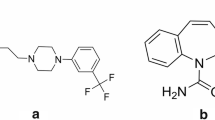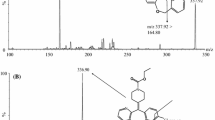Abstract
A simple, sensitive and rapid ultra-performance liquid chromatography-mass spectrometry (UPLC-MS) method was developed and validated for the quantification of mitragynine in rat plasma using amitriptyline hydrochloride as an internal standard. Sample preparation involved a one-step liquid–liquid extraction using methyl t-butyl ether. Mitragynine was separated on an Acquity UPLC™ BEH HILIC column using isocratic elution with a mobile phase of 10 mM ammonium formate buffer containing 0.1% formic acid:acetonitrile (15:85, v/v). At a flow rate of 0.2 mL min−1, the retention time of mitragynine was found to be 1.3 min. Ionization was performed in the positive ion electrospray mode. The selected mass-to-charge (m/z) ratio transition of mitragynine ion [M + H]+ used in the selected ion recording (SIR) was 399.1. The calibration curve was found to be linear over a concentration range of 1–5,000 ng mL−1 (r = 0.999) with a lower limit of quantification (LLOQ) of 1 ng mL−1. Intra- and inter-day assay variations were found to be less than 15%. The extraction recoveries ranged from 85–93% at the three concentrations (2, 400 and 4,000 ng mL−1) in rat plasma. This method was successfully used to quantify mitragynine in rat plasma following intravenous administration of the compound.



Similar content being viewed by others
References:
Moklas M.A.M NRAR, Taufik Hidayat M, Sharida F, Farah Idayu N, Zulkhairi A, Shamima A.R (2008) Adv in Med Dent Sci 2:56–60
Matsumoto K, Hatori Y, Murayama T, Tashima K, Wongseripipatana S, Misawa K, Kitajima M, Takayama H, Horie S (2006) Eur J Pharmacol 549:63–70
Boyer EW, Babu KM, Adkins JE, McCurdy CR, Halpern JH (2008) Addiction 103:1048–1050
Assanangkornchai S, Muekthong A, Sam-Angsri N, Pattanasattayawong U (2007) Subst Use Misuse 42:2145–2157
Kikura-Hanajiri R, Kawamura M, Maruyama T, Kitajima M, Takayama H, Goda Y (2009) Forensic Toxicol 27:67–74
Watanabe K, Yano S, Horie S, Yamamoto LT (1997) Life Sci 60:933–942
Matsumoto K, Mizowaki M, Suchitra T, Murakami Y, Takayama H, Sakai S, Aimi N, Watanabe H (1996) Eur J Pharmacol 317:75–81
Thongpradichote S, Matsumoto K, Tohda M, Takayama H, Aimi N, Sakai S, Watanabe H (1998) Life Sci 62:1371–1378
Kumarnsit E, Vongvatcharanon U, Keawpradub N, Intasaro P (2007) Neurosci Lett 416:128–132
Matsumoto K, Horie S, Ishikawa H, Takayama H, Aimi N, Ponglux D, Watanabe K (2004) Life Sci 74:2143–2155
Suwanlert S (1975) Bull Narc 27:21–27
McWhirter L, Morris S (2010) Eur Addict Res 16:229–231
Babu KM, McCurdy CR, Boyer EW (2008) Clin Toxicol (Phila) 46:146–152
Farah Idayu N, Taufik Hidayat M, Moklas MA, Sharida F, Nurul Raudzah AR, Shamima AR, Apryani E (2010) Phytomedicine article in press
Philipp AA, Wissenbach DK, Zoerntlein SW, Klein ON, Kanogsunthornrat J, Maurer HH (2009) J Mass Spectrom 44:1249–1261
Lu S, Tran BN, Nelsen JL, Aldous KM (2009) J Chromatogr B Analyt Technol Biomed Life Sci 877:2499–2505
de Moraes NV, Moretti RAC, Furr EB III, McCurdy CR, Lanchote VL (2009) J Chromatogr B 877:2593–2597
Chittrakarn S, Keawpradub N, Sawangjaroen K, Kansenalak S, Janchawee B (2010) J Ethnopharmacol 129:344–349
Janchawee B, Keawpradub N, Chittrakarn S, Prasettho S, Wararatananurak P, Sawangjareon K (2007) Biomed Chromatogr 21:176–183
Parthasarathy S, Ramanathan S, Ismail S, Adenan MI, Mansor SM, Murugaiyah V (2010) Anal Bioanal Chem 397:2023–2030
Li L, Pabbisetty D, Zhu S, Avery MA, Avery BA (2008) J Chromatogr Sci 46:215–219
Ponglux D, Wongseripipatana S, Takayama H, Kikuchi M, Kurihara M, Kitajima M, Aimi N, Sakai S (1994) Planta Med 60:580–581
Takayama H, Ishikawa H, Kitajima M, Aimi N, Aji BM (2004) Chem Pharm Bull (Tokyo) 52:359–361
Carvalho P, Furr EB III, McCurdy C (2009) Acta Crystallographica Section E 65:o1441–o1442
Guidance for industry, bioanalytical method validation, US Department of Health and Human Services, Food and Drug Administration, May, 2001 BP. Available: http://www.fda.gov/cv
Booze RM, Lehner AF, Wallace DR, Welch MA, Mactutus CF (1997) Neurotoxicol Teratol 19:7–15
Cornaire G, Woodley J, Hermann P, Cloarec A, Arellano C, Houin G (2004) Int J Pharm 278:119–131
Shin JH, Choi KY, Kim YC, Lee MG (2004) Antimicrob Agents Chemother 48:1756–1762
Lin JH, Hooke KF, Yeh KC, Duggan DE (1985) J Pharmacol Exp Ther 235:402–406
Hewavitharana AK, Lee S, Dawson PA, Markovich D, Shaw PN (2008) Anal Biochem 374:106–111
Acknowledgments
The project described was supported by grant number P20RR021929 from the National Center for Research Resources. The content is solely the responsibility of the authors and does not necessarily represent the official views of the National Center for Research Resources or the National Institutes of Health. This investigation was conducted in a facility constructed with support from research facilities improvement program C06 RR-14503-01 from the National Center for Research Resources.
Author information
Authors and Affiliations
Corresponding author
Rights and permissions
About this article
Cite this article
Vuppala, P.K., Boddu, S.P., Furr, E.B. et al. Simple, Sensitive, High-Throughput Method for the Quantification of Mitragynine in Rat Plasma Using UPLC-MS and Its Application to an Intravenous Pharmacokinetic Study. Chromatographia 74, 703–710 (2011). https://doi.org/10.1007/s10337-011-2128-x
Received:
Revised:
Accepted:
Published:
Issue Date:
DOI: https://doi.org/10.1007/s10337-011-2128-x




